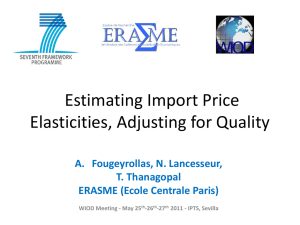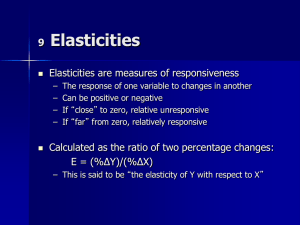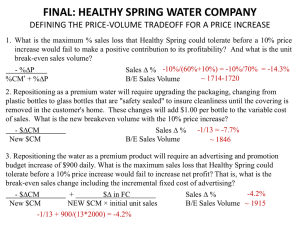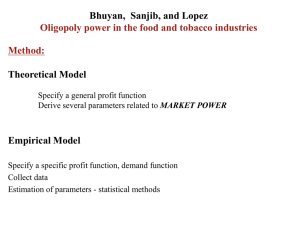Econ 604 Advanced Microeconomics
advertisement
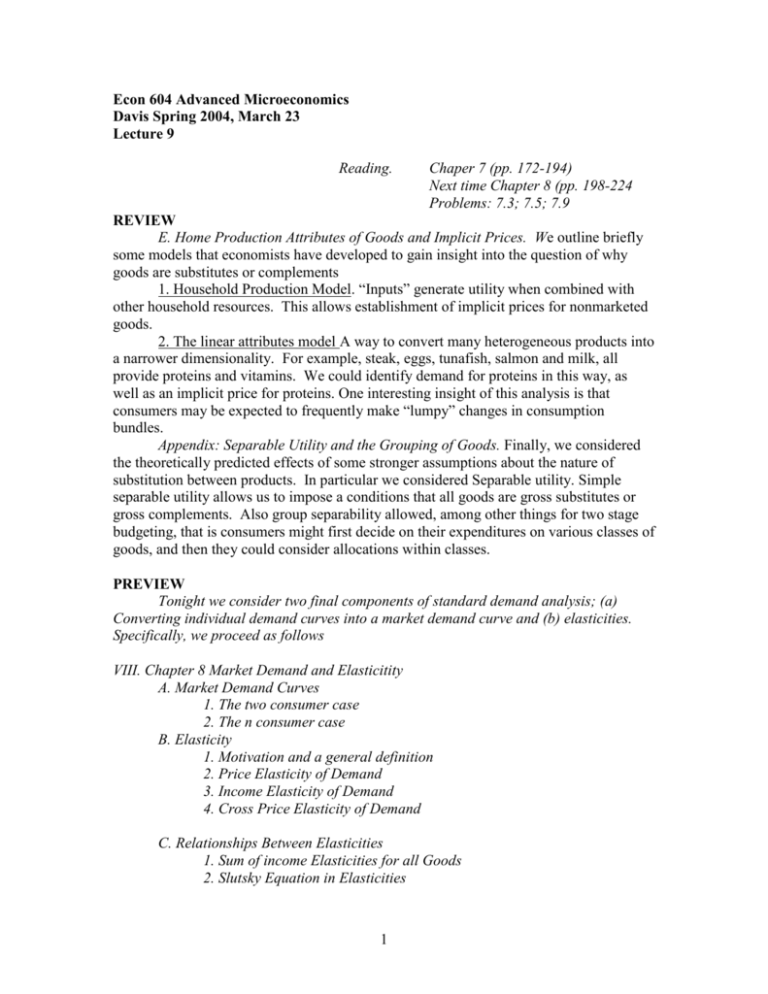
Econ 604 Advanced Microeconomics Davis Spring 2004, March 23 Lecture 9 Reading. Chaper 7 (pp. 172-194) Next time Chapter 8 (pp. 198-224 Problems: 7.3; 7.5; 7.9 REVIEW E. Home Production Attributes of Goods and Implicit Prices. We outline briefly some models that economists have developed to gain insight into the question of why goods are substitutes or complements 1. Household Production Model. “Inputs” generate utility when combined with other household resources. This allows establishment of implicit prices for nonmarketed goods. 2. The linear attributes model A way to convert many heterogeneous products into a narrower dimensionality. For example, steak, eggs, tunafish, salmon and milk, all provide proteins and vitamins. We could identify demand for proteins in this way, as well as an implicit price for proteins. One interesting insight of this analysis is that consumers may be expected to frequently make “lumpy” changes in consumption bundles. Appendix: Separable Utility and the Grouping of Goods. Finally, we considered the theoretically predicted effects of some stronger assumptions about the nature of substitution between products. In particular we considered Separable utility. Simple separable utility allows us to impose a conditions that all goods are gross substitutes or gross complements. Also group separability allowed, among other things for two stage budgeting, that is consumers might first decide on their expenditures on various classes of goods, and then they could consider allocations within classes. PREVIEW Tonight we consider two final components of standard demand analysis; (a) Converting individual demand curves into a market demand curve and (b) elasticities. Specifically, we proceed as follows VIII. Chapter 8 Market Demand and Elasticitity A. Market Demand Curves 1. The two consumer case 2. The n consumer case B. Elasticity 1. Motivation and a general definition 2. Price Elasticity of Demand 3. Income Elasticity of Demand 4. Cross Price Elasticity of Demand C. Relationships Between Elasticities 1. Sum of income Elasticities for all Goods 2. Slutsky Equation in Elasticities 1 3. Homogeneity D. Types of Demand Curves 1. Linear Demand 2. Constant Demand Elasticty Lecture________________________________________________ VIII. Chapter 8 Market Demand and Elasticitity. We have considered in some detail price and quantity effects for a particular consumer. Suppose now we consider the effects of aggregating across consumers. We also devote some attention to the elasticity measures very widely used in empirical work A. Market Demand Curves 1. The two consumer case. Consider an economy that consists of two consumers (person 1 and person 2). Their individual (uncompensated) demand curves for a good X may be written as X1 = d1x(PX, PY, I1) and X2 = d2x(PX, PY, I2) Market demand is simply the sum of individual demands for good X. Thus Total X = X1 + X2 = D(PX, PY, I1,I2) = d1x(PX, PY, I1) + d2x(PX, PY, I2) Observations: - If each individual’s demand curve for good X (holding PY,I1 and I2 fixed) is downsloping, market demand for good X will be downsloping as well. - Market demand here is created from uncompensated individual demands. Compensated Market demand could be constructed in the same way. 2 Graphically, market demand is simply the horizontal summation of individual demands (e.g., a P P P P1 X1 Individual 1 X2 Individual 2 X1 + Market X2 Factors that shift individual demands would generally shift market demand in a similar manner. - A change in the price of a related good can affect all individual demands uniformly. - Income effects, however, are a bit more complicated, since incomes can change differently for different individuals. The way the income changes can affect demand. (This is often overlooked) Example: Consider two consumers with the following simple linear demand curves for Oranges X1 = 10 2PX + .1I1 + .5PY X2 = 17 PX + .05I1 + .5PY Where PX = Price of oranges Ii = Individual i’s income (in thousands of dollars) PY = Price of Grapefruit (a gross substitute for Oranges) Market Demand becomes DX = X1 + X2 = 27 - 3PX + .1I1 + .05I2 + PY (Notice that we can sum across PX and PY, assuming the law of one price. On the other hand, we cannot sum across individual incomes.) To graph DX, we nee values for the variables other than own price. Let I1 = 40, I2 = 20 and PY = 4. Then DX = 27 - 3PX + .1(40) + .05(20) 3 + 4 = = 27 + 9 36 - 3PX 3 PX If the price of grapefruit were to rise to $6, then demand would shift out to DX = = = 27 - 3PX 27 + 11 39 + .1(40) + .05(20) 3PX 3 PX + 6 On the other hand, setting PY = 4 again, impose a redistributive income tax that takes 10 from 1 and transferrs it to 2. The following results: DX = 27 - 3PX + .1(30) + .05(30) + 4 = 27 + 8.5 3PX = 35.5 3 PX Notice that none of these changes affects the market coefficient on own prices. 2. The n consumer case This simple analysis with two consumers extends readily to the case of n consumers. Given a representative consumer j with demand for good i Xij = dij(P1, … , Pn, Ij) Then the market demand for m consumers would be Xi = Xij = Ddi(P1, … , Pn, I1, I2,…,In ) B. Elasticity 1. Motivation and a general definition As we have seen, economists are often interested in the way that one variable A affects another variable B. Economists, for example, are often interested in the way that changes in various prices affect the quantity demanded of a good. An important problem with such comparisons is that the variables are not measured in readily comparable terms (for example, steak is measured in pounds, the price is in dollars. Oranges may be sold by the dozen, and price changes may be on the order of dimes. One coherent way to address these different units of measure is to denominate all these changes in percentage terms. This of elasticity eB,A = percentage change in B percentage change in A = B/B = A/A BA AB Notice from the definition that elasticity is a(n inverse) slope coefficient, weighted by a location. We know, for example, that apple consumption will decrease with an increase in the price of apples. However, the location allows us to speak more meaningfully of the magnitude of the response. 4 2. Price Elasticity of Demand Perhaps the most important elasticity measure is own price elasticity, or the responsiveness of changes in a price on the quantity of that good consumed. a. Definition eQ,P = percentage change in Q percentage change in P = Q/Q = P/P QP PQ Barring a Giffen Good relationship, own price elasticity measures are always negative numbers (since Q/P<0). However, economists often divide goods by the magnitude of the quantity response. If |eQ,P|<-1, then consumers are said to be insensitive, or inelastic consumers of a good. On the other hand, if |eQ,P|>-1 then consumers are said to be sensitive. b. Price Elasticity and Total Expenditures. A common way to explain these notions of “sensitivity” and “insensitivity” is in terms of the effects of a price change on total expenditures. Recall, that total expenditures equal PQ. Write Q as a function of P (for example Q = 10 –P ; to raise quantity one must lower price). Then take the partial derivate w.r.t. P. PQ(P) P = Q Pulling Q out of the RHS TR = (1 P + Q(P) P + eQ,P )Q Notice that TR will move with price if demand is inelastic ( |eQ,P|<1) and TR will move inversely with price if demand if elastic (|eQ,P|>1). Graphically, this can easily be seen by considering price changes at different points along a linear demand curve. P P P Price box P 1 Qty Box Qty Box> Price Box Elastic Segment Qty Box = Price Box Unitary Elastic Segment 5 Qty Box < Price Box Inelastic Segment In the leftmost panel, observe that when price changes, the effects on total revenue can be divided into a “price box” and a “quantity box”. In the case of a price reduction, for example, the price box is the revenues lost from units that would have sold at the higher price (Dimension PQ). The quantity box denotes the extra revenues realized from lower the price (Dimension QP). The left panel illustrates a situation where TR moves inversely with the price change. This is an elastic segment of the demand curve (recall |eQ,P| = |(Quantity box)/ (Price Box)| = |QP /QP| >1). People are price sensitive in the sense that total revenue increases when price falls. The right most panel illustrates an inelastic segment (|eQ,P| = |(Quantity box)/ (Price Box)| = |QP /QP| <1), Here consumers are price insensitive, in the sense that TR falls with a price reduction – or, equivalently, TR increases with a price increase. More revenues are gained from consumers staying in the market and paying the higher price than are lost from consumers leaving the market. The middle panel illustrates a unitary elastic segment, where the price box just equals the quantity box (and eQ,P| = |(Quantity box)/ (Price Box)| = |QP /QP| =1). Here the price and quantity boxes indicate that price and quantity effects are exactly offsetting. 3. Income Elasticity of Demand Another standard type of elasticity assesses the responsiveness of consumers to a change in income levels. This is termed income elasticity of demand eQ,I = percentage change in Q percentage change in I = Q/Q = I/I QI IQ Unlike own price elasticity, income elasticity can be positive or negative. The sign and the magnitude of income elasticity is important. eQ,I > 1 0 < eQ,I eQ,I < < 1 0 goods are luxury goods or cyclical normal goods (e.g., automobiles) goods are normal goods (e.g., food) goods are inferior goods 4. Cross Price Elasticity of Demand Another standard elasticity deals with the response of one good to the change in the price of a related good. This is termed cross price elasticity eQ,P’ = percentage change in Q percentage change in P’ = Q/Q = P’/P’ QP’ PQ As with income elasticities, cross price elasticities can be positive or negative. The sign is important. eQ,P’>0 implies goods are substitutes eQ,P’<0 implies goods are complements (the same as own price changes) 6 Example: Elasticities are easily understood in terms of a linear demand function. For example, consider the market demand function X = 10 2PX + .1I1 + .5PY Obviously, the positive coefficient on the income parameter indicates that the good is a normal good, while the positive coefficient on PY indicates that the products are substitutes. Suppose PX = 5, I = 40 and PY = 4. Then X = 10 -2(5) + .1(40) + .5(4) = 6 Then eQ,P = -2(5)/6 = eQ,I = .1(40)/6 = eQ,P’ = .5(4)/6 = -1.67, the firm is on the elastic portion its demand curve 0.67, the product is a normal, noncyclical good. 0.33, good Y is a substitute. C. Relationships Between Elasticities 1. Sum of income Elasticities for all Goods. We have developed elasticity in terms of market demand. If we further treat individuals uniformly as representative consumers, then we can derive some important relationships between elasticities. Consider the case of homogeneous customers with two goods, forming the market budget constraint is PXX + PYY = I. Market demands for X and Y are X = dX(PX, PY, I) and Y = dY(PX, PY, I). Further, assume these demand functions are homogeneous of degree zero in prices and income. Differentiating the budget constraint w.r.t. I, PX(X/I) + PY(Y/I) = 1 This expression can be readily converted into elasticities . (PXX/I)(X/I)I/X + (PYY/I )(Y/I)I/Y writing PXX/I = sx sxeX,I = 1 and PYY/I = sy yields + sYeY,I = 1 Thus, the share weighted sum of the income elasticities for all good equals 1. (e.g., if income increases 10%, expenditures must increase 10%). Thus, for every “luxury” good (with income elasticity greater than 1) there must be offsetting goods witn income elasticities less than 1. 7 2. Slutsky Equation in Elasticities Recall in chapter 5 the Slutsky equation X PX = X | PX |U = constant - X X I This expresión may be converted into elasticities by multiplying by PX/X X PX = PX X X PX | PX X |U = constant eXP = eSXP eSXP denotes the compensated price elasticity of demand and denotes the share of income spent on X. - - X[ X I ] PX IX I eXI sx Where sx Notice that the above (bolded expression provides an additional reason to use uncompensated demand: When sx is small uncompensated and compensated elasticities are very similar. 3. Homogeneity As a final example of relationships between elasticities, we exploit the fact that demand functions are homogeneous of degree zero in prices and income. Prior to developing this relationship, we review Euler’s Theorem. A function that is homogeneous of degree m, means that, for any t>0. f(tX1, tX2, …. , tXn) = tmf(X1, X2, …. , Xn). Thus a function that is homogenous of degree zero implies f(tX1, tX2, …. , tXn) = f(X1, X2, …. , Xn). Euler’s theorem states that a function that is homogeneous of degree m, then f1X1+ f2X2 +… fnXn = mf(X1, X2, …. , Xn) When m=0, then the Euler’s theorem states that the sum of the quantity weighted first derivatives equals zero. Now, consider a demand function X = dx(Px, Py, I) 8 By Euler’s Theorem+ (X/PX) PX + (X/PY)PY +(X/I)I = 0 Convert to elasticities by dividing by X, (X/PX) PX /X+ (X/PY)PY/X +(X/I)I/X = 0/X eX,Px + e X,Py + e X,,I = 0 This is another way to state the homogeniety of degree zero property of demand functions. An equal percentage change in all prices and incomes will leave the quantity demanded of X unchanged. Example: Cobb-Douglas Elasticities Consider the Cobb Douglas demand function U(X,Y) = XY where + = 1. Demand functions are X = I/PX Y = I/PY The elasticities are easy to calculate. For example, eX,Px = = = (X/PX) PX /X = (-I/PX2)( PX2 /I ) -1 = 1 eX,Py = 0 eY,Py = -1 eY,I = 1 eY,Px = 0 Similarly eX,I (-I/PX2)( PX /X) Hence these demand functions have elementary elasticity values. Further sX = PXX/I = sY = PYY/I PXI/PXI 9 = = The constancy of income shares provides another way of shown the unitary elasticity of demand. Homogeneity holds trivially, eX,Px + e X,Py + e X,,I = 0 -1 + 0 -1 + = 0 Finally, consider the elastcity version of the Slutsky equation. eXP = eSXP - sx eXI -1 = eSXP - (1) = -(1 - ) = - Thus eSXP In words, the compensated price elasticity of demand for one good is the income share for the other good. This is special case of the more general result that eSXP = -(1 - sx) where is the elasticity of substitution in chapter 3 (note 6). D. Types of Demand Curves. Economists consider various types of demand forms. Here in closing we consider some of the problems associated with two of these functions. 1. Linear Demand Consider a demand function of the form Q = a + bP + cI + dP’ Where a, b, c and d are demand parameters, and . b<0 (the good is not a giffen good) c>0 (the good is normal) d< > 0 if the related good is a gross substitute or a gross complement. Holding I and P’ constant Q = a’ + bP Where a’ = a + cI + dP’. Clearly this describes a l linear demand curve. Further, changes in a’ will shift demand. Despite the simplicity of this demand statement. Linear demand has the deficiency that elasticity changes as one moves along the demand function. To see this notice that 10 eX,Px = (X/PX) PX /X = bP/Q Obviously as P rises Q falls, and demand becomes more elastic. Example: Linear Demand. Consider a demand function Q = 36 – 3P. Price elasticity of demand is eX,Px = -3P/Q = -3P/(36 – 3P) Notice demand is unit elastic when P = 6. For P>6 demand is elastic. For P<6 demand is inelastic. Because elasticity varies with price on a linear demand curve, one must be very careful to specify the point at which elasticity is being measured. In empirical work with linear demand curves, it is conventional to report the arc price elasticity, that is, the average elasticity over the average price prevailing for a period. 2. Constant Elasticity Demand If one want to assume that elasticities are constant use an exponential function. Q = aPbIcP’d Where a>0, b<0, c>0 (a normal good) and d<>0, as for the linear good. Notice that one can easily “linearize” such a function by taking natural logarithms (ln) lnQ = lna + blnP + clnI + dlnP’. Notice that one can estimate the parameters of such a function with ordinary least squares. Notice also that eQ,P = (Q/P) P /Q = b aPb-1IcP’d P/(aPbIcP’d) = b Thus, the price elasticity of demand is constant. Example: Elasticities, Exponents and Logarithms. Notice in the above example that income and cross price elasticities are also directly read from the exponents of the demand functions eQ,I = c ; eQ,P’ = d Therefore, from a linear regression, one can read elasticities without having to make any mathematical computations. For example, if one estimated lnQ = 4.61 We know that eQ,P = and eQ,P’ = - 1.5lnP + .5ln(I) + ln(P’) -1.5 1 ; eQ,I = 11 .5 12


